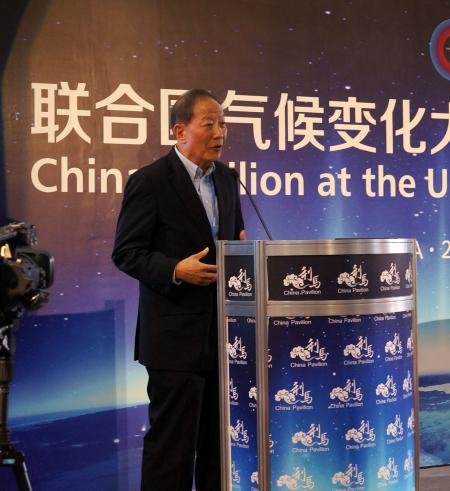 President Andrew Steer, Vice President Al Gore, Minister Xie Zhenhua, UNEP Executive Director Achim Steiner and Vanke Chairman Wang Shi at the opening of the Making the Future of Cities Green event at the China Pavilion. ©Alvin Lin/NRDC
President Andrew Steer, Vice President Al Gore, Minister Xie Zhenhua, UNEP Executive Director Achim Steiner and Vanke Chairman Wang Shi at the opening of the Making the Future of Cities Green event at the China Pavilion. ©Alvin Lin/NRDC
The COP 20 negotiations in Lima, Peru have entered the final push, with negotiating parties seeking a deal out of Lima that sets a clear path for reaching an agreement in Paris next year that puts the globe on a path to rapidly reducing greenhouse gas emissions. China and the US, through their joint climate announcement in Beijing last month, have given the talks new momentum (see here for the backstory on how they reached a deal), adding to the EU's 2030 climate commitment to reduce its emissions by 40% by 2030.
While parties negotiate, it's worth remembering that the agreement we are seeking is one that brings about change at home, helping and encouraging countries, subnational entities such as provinces, states, and cities, enterprises and all of us to take concrete actions to mitigate emissions and adapt to climate change. In China, that means first capping coal consumption and next capping emissions from oil.
First step: Capping greenhouse gas and air pollution emissions from coal in China...
China’s announcement that it would peak its CO2 emissions by 2030 or earlier and scale up non-fossil energy to 20% of total energy by 2030 sends a strong signal domestically and internationally that the time for ever-increasing consumption of fossil fuels is over, and the time for rapid scale-up of cleaner energy sources and smarter urban and economic development is here. (See our blog post on how we know China is serious about this commitment.)
In order to cap its CO2 emissions, China is first putting in place a coal consumption cap and complementary policies in the next Five Year Plan, making clear to investors and industry that coal is not the energy source to direct future investment in the coming decades (see my colleague Barbara Finamore's blog on China's most recent announcement for a national coal cap for 2020 in its National Energy Development Strategy Action Plan). There is already too much capacity in the coal mining industry, as well as industries such as iron and steel and cement which are some of the largest consumers of coal, and the government is determined to re-structure the economy away from heavy industry to a more services and technology driven development model. The coal cap policy is a way to simultaneously tackle China's severe air pollution problems, and at the same time help re-balance and upgrade China's energy and economic structure—both top priorities of the country's leadership.
In fact, coal consumption in China this year has actually fallen, a stunning reversal after more than a decade of nearly 10% annual growth. Coal-fired power generation this year is flat, with negative growth in power generation year-on-year in the last 4 months (Chinese), and 20 provinces consuming less coal-fired power in October 2014 than they did in October 2013. The rate of construction for new coal power plants has fallen by half what it was a few years ago, while the National Energy Development Strategy Action Plan has set ambitious targets for wind power and solar PV capacity to reach 200 GW and 100 GW by 2020, from 75 GW (grid connected) and nearly 20 GW at the end of 2013, making clear that companies, provinces and cities should scale up investment in these clean energy sources. By 2030, China will need to build 800-1000 GW of new wind, solar, hydro and nuclear to reach its 20% non-fossil energy target, basically re-building the entire electricity system using low carbon energy sources (China's entire electricity system had 1250 GW of installed capacity (Chinese) by the end of 2013). (See here for a CCTV American interview I did on coal versus renewables growth in China on the sidelines of the COP.)
 NRDC's Fuqiang Yang discussing China's coal consumption cap policy and the findings of the China Coal Consumption Project at the China Pavilion at COP 20. ©Alvin Lin/NRDC
NRDC's Fuqiang Yang discussing China's coal consumption cap policy and the findings of the China Coal Consumption Project at the China Pavilion at COP 20. ©Alvin Lin/NRDC
As my colleague Yang Fuqiang discussed at the China Pavilion earlier this week, capping coal consumption will bring enormous air, water, health and other benefits to China, and will help the country to transition to a more sustainable, higher-quality growth path, findings supported by the China Coal Consumption Cap Plan and Project Research Project that NRDC is supporting. The current focus on regional and a future national coal consumption cap is being driven by the intense focus of policymakers on reducing China's PM 2.5 air pollution, 50-60% of which is from coal and coal-related industries. A future price on coal—through integration with the national carbon cap and trade program set to begin in 2016 and/or a carbon tax—will be an important complement to strengthened energy efficiency and low-carbon energy policies for achieving the coal cap. (See here for a recent Resources for the Future paperassessing the design of three current carbon trading pilots and making recommendations for improvement.)
...while putting in place low-carbon transportation systems and cities to next peak greenhouse gas emissions from oil in China
The next step to capping China's greenhouse gas emissions by 2030 and greatly improving air quality and other environmental and health measures is to address China's rising oil consumption. China is now the second largest oil consumer, behind the US, and is projected by the US EIA to become the world's largest oil importer this year. These trends not only add to China's concerns about energy security, but oil of course is China's next largest source of greenhouse gas and air pollutant emissions from fossil fuels.
But rising oil consumption can be capped in China by 2025 by putting in place policies today to make cars more efficient and to scale up conversion to an electric vehicle fleet, and designing smart cities and public transportation systems to reduce the demand for driving. At a side event earlier this week, NRDC and four partner organizations working on low carbon urbanization in China, the Environmental Defense Fund, Energy Foundation China, Institute for Sustainable Communities, and World Resources Institute, jointly released a new report on "Climate Change and Urbanization: Challenges and Progress in China" detailing some of the best practices for low carbon urbanization being implemented in China today. These include good practices in three areas in which Chinese cities are seeking climate-friendly solutions: efficient land use, transportation and urban energy efficiency.
Some of the case studies featured in the report include:
• Efficient land use
o Shanghai's use of "landless investment" to increase land use intensity
o Kunming's transit-oriented, mixed land use in the Chenggong New Town.
o Tianjin's integrated planning process in the Binhai New Area
• Green transportation
o Asia's first—and the world's second largest—Bus Rapid Transit (BRT) system in Guangzhou, which is being replicated in many other Chinese cities.
o Hangzhou's public bicycle rental system and walkable cities such as Hong Kong, Shenzhen, Shanghai, Guangzhou and Dalian
o Wuhan's community carpooling low-carbon travelling initiative
• Urban energy efficiency
o National low-carbon pilot programs at the city and provincial level
o Net-zero energy use buildings pilot programs
o Energy retrofits for existing buildings in Northern China
 Lei Hongpeng from WRI introducing the case studies and recommendations of the Climate Change and Urbanization: Challenges and Progress in China report at the China Pavilion. ©Alvin Lin/NRDC
Lei Hongpeng from WRI introducing the case studies and recommendations of the Climate Change and Urbanization: Challenges and Progress in China report at the China Pavilion. ©Alvin Lin/NRDC
WRI's Lei Hongpeng introduced the report on behalf of the five organizations, noting that Chinese cities need to practice transit-oriented development so that transportation and urban planning can be closely integrated. Reducing the demand for private cars and strengthening non-motorized transit systems should be priorities while Chinese cities promote sustainable development.
Bringing About Positive Action on Climate in Paris and in China
As the negotiators finalize the Lima agreement for what will be required of countries in putting forth their commitments next year, it's worth remembering that outside the walls of the negotiating rooms, actions are already being taken at all levels. The Climate Secretariat's new online portal of climate actions by non-state actors, including provinces, cities, companies and cooperative initiatives, was released yesterday. China is developing its own South-South Cooperation Fund to help developing countries address climate change.
Within China, the government is also putting in place new and strengthened policies to make good on its commitment to cap its CO2 emissions by 2030 or earlier, by tackling the greenhouse gas and air pollutant emissions from coal and oil, and putting in place policies to cap the consumption of these fossil fuels and replace them with cleaner energy sources. These are actions that will have far-reaching impacts at home in China and in the global efforts to address climate change.


